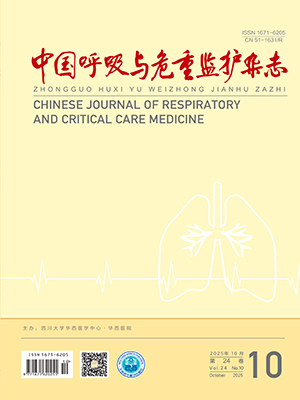| 1. |
Sabaté S, Mazo V, Canet J. Predicting postoperative pulmonary complications: implications for outcomes and costs. Curr Opin Anaesthesiol, 2014, 27(2): 201-209.
|
| 2. |
Meyhoff CS, Staehr AK, Rasmussen LS. Rational use of oxygen in medical disease and anesthesia. Curr Opin Anaesthesiol, 2012, 25(3): 363-370.
|
| 3. |
Barkauskas CE, Cronce MJ, Rackley CR, et al. Type 2 alveolar cells are stem cells in adult lung. J Clin Invest, 2013, 123(7): 3025-3036.
|
| 4. |
Chroneos ZC, Sever-Chroneos Z, Shepherd VL. Pulmonary surfactant: an immunological perspective. Cell Physiol Biochem, 2010, 25(1): 13-26.
|
| 5. |
Tantawy AA, Adly AA, Ebeid FSE, et al. Surfactant protein D as a marker for pulmonary complications in pediatric patients with sickle cell disease: Relation to lung function tests. Pediatr Pulmonol, 2019, 54(5): 610-619.
|
| 6. |
Du J, Abdel-Razek O, Shi Q, et al. Surfactant protein D attenuates acute lung and kidney injuries in pneumonia-induced sepsis through modulating apoptosis, inflammation and NF-κB signaling. Sci Rep, 2018, 8: 15393-15406.
|
| 7. |
Jin Y, Peng LQ, Zhao AL. Hyperoxia induces the apoptosis of alveolar epithelial cells and changes of pulmonary surfactant proteins. Eur Rev Med Pharmacol Sci, 2018, 22(2): 492-497.
|
| 8. |
Suzuki S, Mihara Y, Hikasa Y, et al. Current ventilator and oxygen management during general anesthesia: a multicenter, cross-sectional observational study. Anesthesiology, 2018, 129(1): 67-76.
|
| 9. |
Wolthuis EK, Choi G, Dessing MC, et al. Mechanical ventilation with lower tidal volumes and positive end-expiratory pressure prevents pulmonary inflammation in patients without preexisting lung injury. Anesthesiology, 2008, 108(1): 46-54.
|
| 10. |
Ozdemir R, Demirtas G, Parlakpinar H, et al. Dexpanthenol therapy reduces lung damage in a hyperoxic lung injury in neonatal rats. J Matern Fetal Neonatal Med, 2016, 29(11): 1801-1807.
|
| 11. |
柳娟, 贾兴元, 张晴, 等. 异丙酚和七氟烷对全麻病人短时间吸入纯氧诱发氧化应激反应的影响. 中华麻醉学杂志, 2010, 30(3): 297-299.
|
| 12. |
Sinclair SE, Altemeier WA, Matute-Bello G, et al. Augmented lung injury due to interaction between hyperoxia and mechanical ventilation. Crit Care Med, 2004, 32(12): 2496-2501.
|
| 13. |
Page D, Ablordeppey E, Wessman BT, et al. Emergency department hyperoxia is associated with increased mortality in mechanically ventilated patients: a cohort study. Crit Care, 2018, 22(1): 9.
|
| 14. |
Helmerhorst HJF, Schouten LRA, Wagenaar GTM, et al. Hyperoxia provokes a time- and dose-dependent inflammatory response in mechanically ventilated mice, irrespective of tidal volumes. Intensive Care Med Exp, 2017, 5(1): 27.
|
| 15. |
Ferguson ND, Fan E, Camporota L, et al. The Berlin definition of ARDS: an expanded rationale, justification, and supplementary material. Intensive Care Med, 2012, 38(10): 1573-1582.
|
| 16. |
Villar J, Ambrós A, Soler JA, et al. Age, PaO2/FIO2, and plateau pressure score: a proposal for a simple outcome score in patients with the acute respiratory distress syndrome. Crit Care Med, 2016, 44(7): 1361-1369.
|
| 17. |
Esteve F, Lopez-Delgado JC, Javierre C, et al. Evaluation of the PaO2/FiO2 ratio after cardiac surgery as a predictor of outcome during hospital stay. BMC Anesthesiol, 2014, 14: 83.
|
| 18. |
Aboab J, Louis B, Jonson B, et al. Relation between PaO2/FiO2 ratio and FiO2: a mathematical description. Intensive Care Med, 2006, 32(10): 1494-1497.
|
| 19. |
Pace PW, Yao LJ, Wilson JX, et al. The effects of hyperoxia exposure on lung function and pulmonary surfactant in a rat model of acute lung injury. Exp Lung Res, 2009, 35(5): 380-398.
|
| 20. |
Gupta A, Zheng SL. Genetic disorders of surfactant protein dysfunction: when to consider and how to investigate. Arch Dis Child, 2017, 102(1): 84-90.
|
| 21. |
Zhang L, Zhao S, Yuan LJ, et al. Autophagy regulates hyperoxia-induced intracellular accumulation of surfactant protein C in alveolar type Ⅱ cells. Mol Cell Biochem, 2015, 408(1-2): 181-189.
|
| 22. |
Jain D, Atochina-Vasserman EN, Tomer Y, et al. Surfactant protein D protects against acute hyperoxic lung injury. Am J Respir Crit Care Med, 2008, 178(8): 805-813.
|




